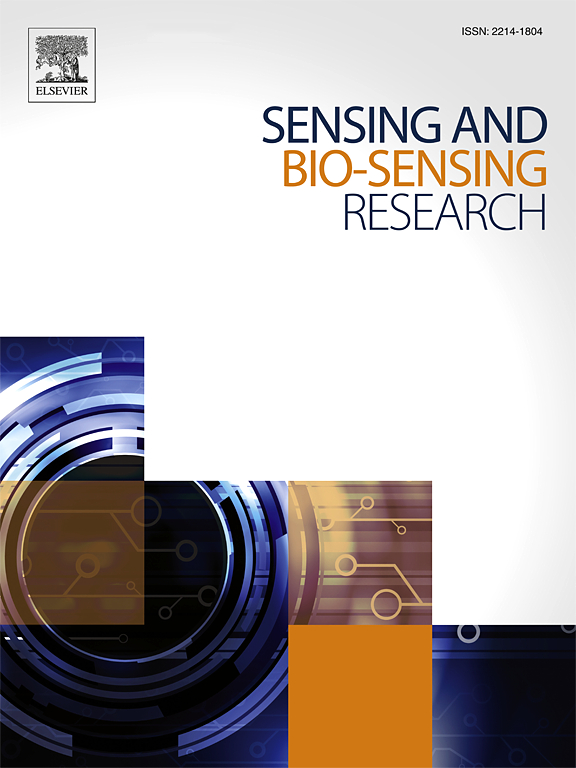A robust and highly sensitive electrochemical probe for detection of trace levels of NH3/NH4+ in water based on Berthelot's reaction
IF 4.9
Q1 CHEMISTRY, ANALYTICAL
引用次数: 0
Abstract
Traditional spectrochemical methods for quantifying NH3/NH4+ based on the colored oxidation product of Berthelot or Nessler reactions, face challenges due to spectral overlap, auto-self absorbance, background scattering noise and high limits of detection. Thus, the current study introduces a new electrochemical sensing platform utilizing an ex-situ Bi film-plated glassy carbon electrode (BiF/GCE) combined with Berthelot's reaction for detecting trace levels of NH3/NH4+ in water. The primary advantage of Bi as a surface modifier of GCE is its ability to provide a selective and explicit probe for NH3/NH4+ detection at trace levels. This platform employs an ex-situ BiF/GCE, square wave-adsorptive anodic stripping voltammetry (Ads SW-ASV), and the oxidation product of Berthelot's reaction for precise indirect detection of NH3/NH4+ in aqueous solutions at pH 10–11. The probe demonstrated excellent electrochemical performance for NH3/NH4+ detection over a concentration range of 3.2 nM to 20.0 μM, with detection and quantitation limits of 0.95 and 3.2 nM, respectively. It showed good selectivity towards detection of NH3/NH4+ in water with favorable repeatability (RSD = ±3.2 %) and reproducibility (RSD = ±4.1 %). The probe's measurements were validated against standard ion chromatography (IC) and microspectrophotometry methods, demonstrating high reliability for detecting NH3/NH4+ in environmental and Red Sea water samples. This assay is precise and versatile for ammonia detection, enabling measurement of trace levels of N-containing organic compounds in foodstuffs and their degradation products.
基于Berthelot反应的检测水中痕量NH3/NH4+的电化学探针
传统的基于Berthelot或nesler反应的有色氧化产物定量NH3/NH4+的光谱化学方法,由于光谱重叠、自吸、背景散射噪声和检测限高而面临挑战。因此,本研究引入了一种新的电化学传感平台,利用非原位Bi膜镀玻璃碳电极(BiF/GCE)结合Berthelot反应来检测水中痕量的NH3/NH4+水平。Bi作为GCE表面改性剂的主要优点是它能够为痕量水平的NH3/NH4+检测提供选择性和明确的探针。该平台采用非原位BiF/GCE,方波吸附阳极溶出伏安法(Ads SW-ASV)和Berthelot反应的氧化产物,用于pH 10-11水溶液中NH3/NH4+的精确间接检测。该探针在3.2 ~ 20.0 μM的浓度范围内对NH3/NH4+进行了良好的电化学检测,检测限为0.95 nM,定量限为3.2 nM。该方法对水中NH3/NH4+的检测具有良好的选择性,重复性好(RSD =±3.2%),重现性好(RSD =±4.1%)。该探针的测量结果与标准离子色谱(IC)和显微分光光度法进行了验证,证明了检测环境和红海水中NH3/NH4+的高可靠性。该分析是精确和通用的氨检测,能够测量食品及其降解产物中含氮有机化合物的痕量水平。
本文章由计算机程序翻译,如有差异,请以英文原文为准。
求助全文
约1分钟内获得全文
求助全文
来源期刊

Sensing and Bio-Sensing Research
Engineering-Electrical and Electronic Engineering
CiteScore
10.70
自引率
3.80%
发文量
68
审稿时长
87 days
期刊介绍:
Sensing and Bio-Sensing Research is an open access journal dedicated to the research, design, development, and application of bio-sensing and sensing technologies. The editors will accept research papers, reviews, field trials, and validation studies that are of significant relevance. These submissions should describe new concepts, enhance understanding of the field, or offer insights into the practical application, manufacturing, and commercialization of bio-sensing and sensing technologies.
The journal covers a wide range of topics, including sensing principles and mechanisms, new materials development for transducers and recognition components, fabrication technology, and various types of sensors such as optical, electrochemical, mass-sensitive, gas, biosensors, and more. It also includes environmental, process control, and biomedical applications, signal processing, chemometrics, optoelectronic, mechanical, thermal, and magnetic sensors, as well as interface electronics. Additionally, it covers sensor systems and applications, µTAS (Micro Total Analysis Systems), development of solid-state devices for transducing physical signals, and analytical devices incorporating biological materials.
 求助内容:
求助内容: 应助结果提醒方式:
应助结果提醒方式:


